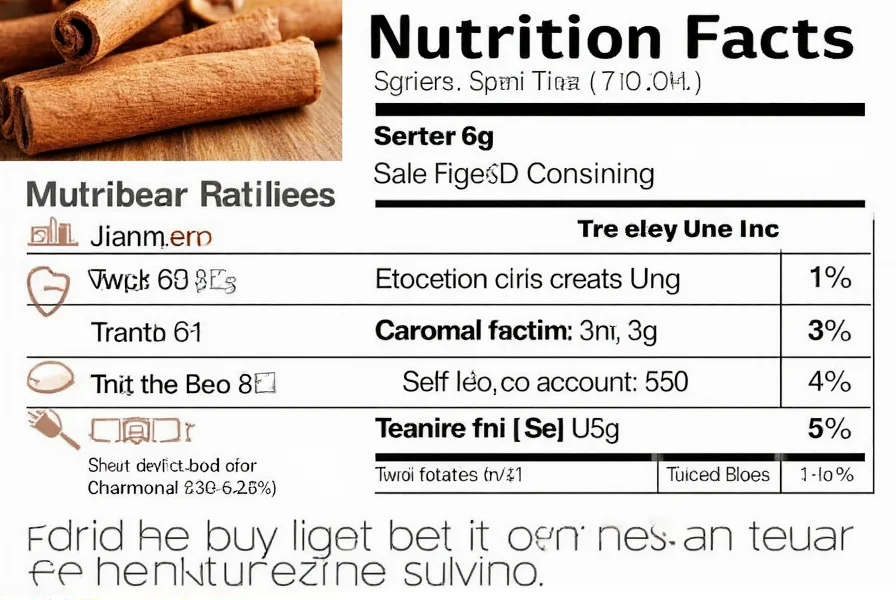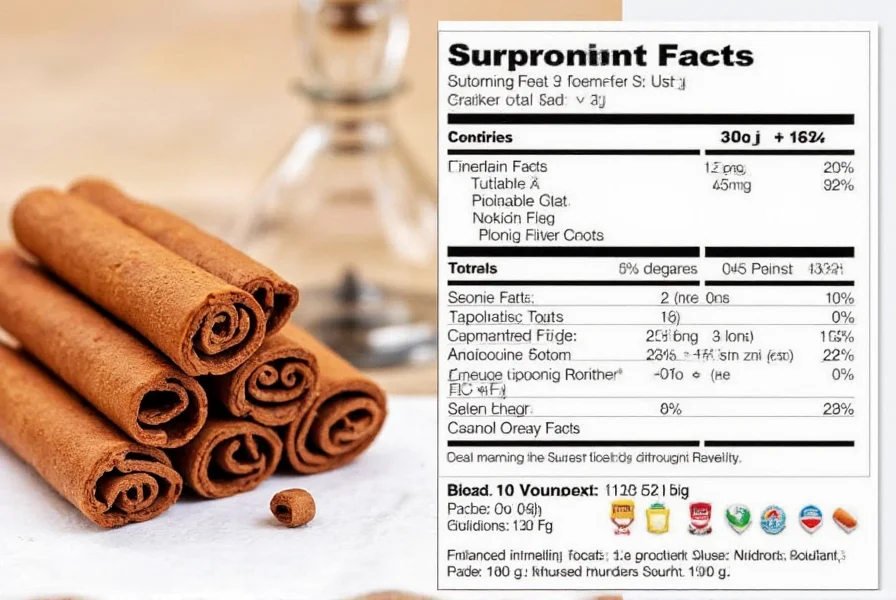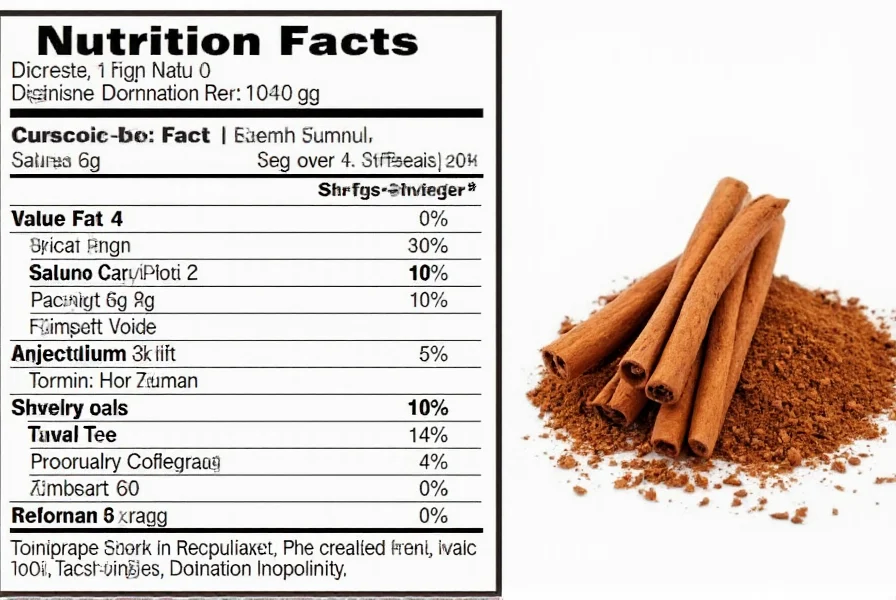One teaspoon (2.6g) of ground cinnamon contains approximately 6 calories, 2.1g carbohydrates, 1.5g fiber, 0.1g sugar, 0.1g fat, and 0.1g protein. It's particularly rich in manganese (providing 19% of the daily value), with notable amounts of calcium, iron, and antioxidants. Ceylon cinnamon contains significantly less coumarin than the more common Cassia variety, making it a safer option for regular consumption.
Understanding cinnamon nutritional content helps you make informed decisions about incorporating this popular spice into your diet. Whether you're monitoring your daily nutrient intake or exploring natural ways to enhance your meals with health benefits, knowing the precise nutritional facts about cinnamon is essential.
Nutritional Profile of Cinnamon per Serving
Cinnamon's impressive nutrient density makes it more than just a flavor enhancer. Let's examine the detailed cinnamon nutrition breakdown based on USDA FoodData Central information.
| Nutrient | Per Teaspoon (2.6g) | Per Tablespoon (7.8g) | % Daily Value* |
|---|---|---|---|
| Calories | 6 | 18 | - |
| Total Carbohydrates | 2.1g | 6.3g | 1% |
| Dietary Fiber | 1.5g | 4.5g | 5% |
| Sugars | 0.1g | 0.3g | - |
| Total Fat | 0.1g | 0.3g | 0% |
| Protein | 0.1g | 0.3g | 0% |
| Manganese | 0.4mg | 1.2mg | 19% |
| Calcium | 26mg | 78mg | 2% |
| Iron | 0.2mg | 0.6mg | 1% |
| Vitamin K | 0.6mcg | 1.8mcg | 1% |
*Percent Daily Values are based on a 2,000 calorie diet. Your daily values may be higher or lower depending on your calorie needs.
Ceylon vs Cassia Cinnamon: Nutritional Differences
When examining cinnamon nutritional information, it's crucial to distinguish between the two main varieties:
- Ceylon cinnamon ("true cinnamon") - Lighter in color, more delicate flavor, contains significantly less coumarin (approximately 0.017g per 100g)
- Cassia cinnamon (most common in supermarkets) - Darker, stronger flavor, contains higher coumarin levels (approximately 2.1-6.0g per 100g)
The coumarin content in cinnamon is particularly important for regular consumers. While coumarin has potential health benefits, excessive intake may cause liver damage in sensitive individuals. The European Food Safety Authority recommends a maximum daily intake of 0.1mg of coumarin per kilogram of body weight.

Health Benefits Supported by Research
The health benefits of cinnamon nutrition extend beyond its impressive micronutrient profile. Scientific research has identified several potential benefits:
Blood Sugar Regulation
Multiple studies suggest cinnamon may improve insulin sensitivity and help lower blood sugar levels. A meta-analysis published in the Journal of the Academy of Nutrition and Dietetics found that cinnamon supplementation significantly reduced fasting blood glucose levels.
Antioxidant Properties
Cinnamon ranks #1 among 26 common spices for antioxidant activity according to research published in the Journal of Agricultural and Food Chemistry. Its high polyphenol content helps combat oxidative stress.
Anti-Inflammatory Effects
The compounds in cinnamon demonstrate anti-inflammatory properties that may help reduce chronic inflammation, a contributor to many diseases.
Practical Usage Recommendations
Understanding how much cinnamon is healthy per day is essential for maximizing benefits while minimizing potential risks:
- For Cassia cinnamon: Limit to 1 teaspoon (2.6g) daily to stay within safe coumarin limits
- For Ceylon cinnamon: Up to 1-2 tablespoons (7.8-15.6g) daily is generally considered safe
- Best consumed with meals to enhance nutrient absorption and blood sugar management
When selecting cinnamon products, look for "Ceylon" on the label if you plan to consume larger amounts regularly. Many premium health food stores now carry Ceylon cinnamon specifically for its lower coumarin content.

Incorporating Cinnamon into a Balanced Diet
The nutritional value of cinnamon in recipes can enhance both flavor and health profile without adding significant calories. Consider these practical applications:
- Add to morning oatmeal or yogurt instead of sugar
- Mix with coffee grounds before brewing
- Use in savory dishes like roasted vegetables or curries
- Create a healthy snack by sprinkling on apple slices
- Add to smoothies for extra flavor and nutrients
Remember that while cinnamon offers notable health benefits, it should be part of an overall balanced diet rather than viewed as a standalone solution for health concerns.
Frequently Asked Questions
How much cinnamon should I consume daily for health benefits?
For Cassia cinnamon, limit to 1 teaspoon (2.6g) daily due to coumarin content. Ceylon cinnamon allows for higher consumption—up to 1-2 tablespoons (7.8-15.6g) daily. Most studies showing health benefits used 1-6 grams daily, but individual tolerance varies.
Is cinnamon good for blood sugar control?
Research suggests cinnamon may improve insulin sensitivity and help lower fasting blood glucose levels. Multiple studies, including a meta-analysis in the Journal of the Academy of Nutrition and Dietetics, have shown significant improvements in blood sugar markers with cinnamon supplementation.
What's the difference between Ceylon and Cassia cinnamon nutritionally?
Both varieties have similar macronutrient profiles, but Ceylon cinnamon contains significantly less coumarin (approximately 0.017g per 100g) compared to Cassia (2.1-6.0g per 100g). Ceylon also tends to have slightly higher antioxidant levels, though both are excellent sources of manganese and other micronutrients.
Can cinnamon help with weight loss?
While cinnamon isn't a weight loss solution on its own, it may support weight management efforts. Its potential to improve insulin sensitivity could help regulate blood sugar and reduce cravings. Additionally, using cinnamon as a flavor enhancer instead of sugar can reduce overall calorie intake when used strategically in recipes.
Does the nutritional value of cinnamon change when cooked?
Most of cinnamon's key nutrients, particularly its antioxidant compounds, remain stable during cooking. Some water-soluble compounds may leach into cooking liquids, but the primary beneficial components like cinnamaldehyde and polyphenols maintain their integrity through typical cooking temperatures. For maximum benefit, add cinnamon toward the end of cooking when possible.











 浙公网安备
33010002000092号
浙公网安备
33010002000092号 浙B2-20120091-4
浙B2-20120091-4